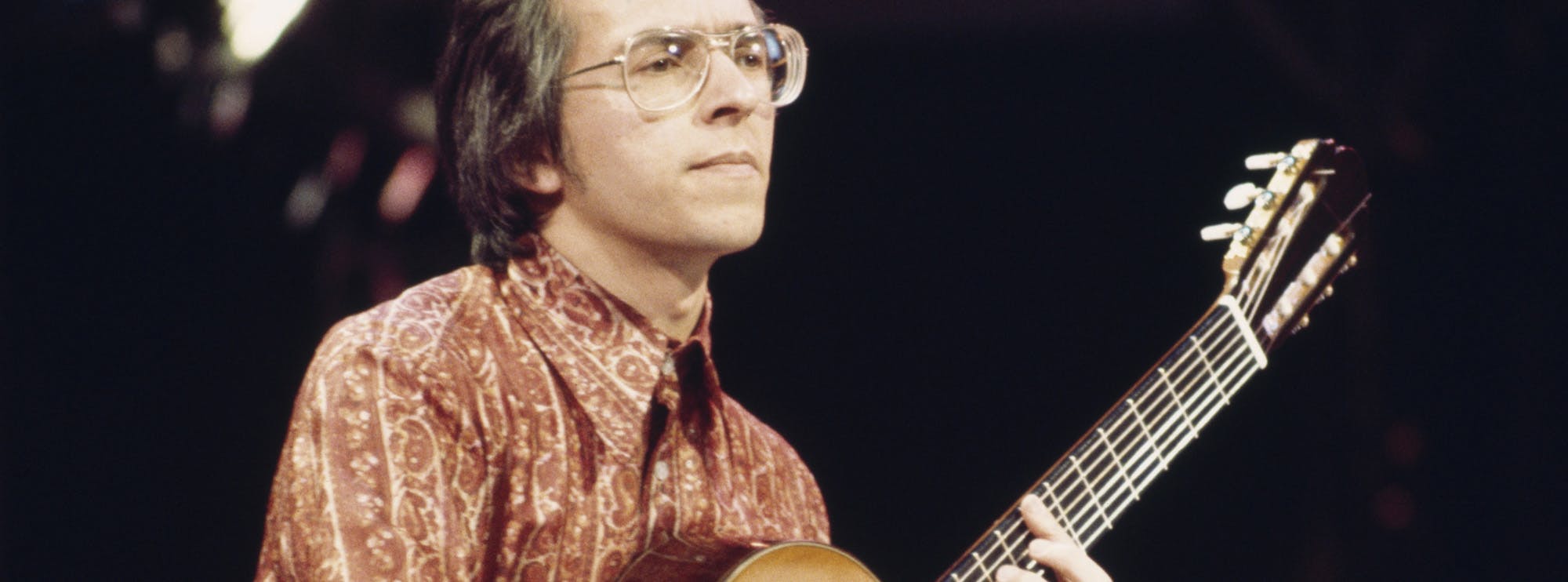"Unplugged" by Eric Clapton: A Comprehensive Guide for Guitarists
"Unplugged" by Eric Clapton is a seminal live album, released in 1992, which showcases the legendary guitarist's virtuosity on the acoustic guitar. Not only is it the bestselling album of Clapton’s career to date, but it’s also the bestselling live album of all time, selling 26 million copies worldwide. The album features a mix of original compositions and cover songs, all performed with an intimate and stripped-down approach.
In this guitar lesson course, LickLibrary veteran, Danny Gill walks you through the many highlights of each song from this acoustic gem, one phrase at a time, including all of Eric Clapton’s legendary guitar parts from the tracks; “Before You Accuse Me,” “Tears In Heaven,” and the iconic, “Layla.”In this guide, we'll delve into the nuances of each song, exploring the guitar techniques, scales, and solos that make this album a must-listen for any guitarist.
1. Signe
"Signe" is an instrumental piece composed by Clapton and features a delicate finger-picked arpeggiated chord progression. The song utilizes the E major and D major scales, with Clapton effortlessly transitioning between the two. The song showcases Clapton's masterful finger-picking technique, as well as his ability to create beautiful melodies using hammer-ons and pull-offs.
2. Before You Accuse Me
A cover of the Bo Diddley classic, "Before You Accuse Me" is played in the key of E and primarily uses the E minor pentatonic scale. Clapton employs double-stops and slides throughout the song, adding depth and texture to the bluesy riffs. The solo showcases Clapton's signature vibrato and string bending techniques, making it a standout moment on the album.
3. Hey Hey
"Hey Hey" is a cover of a Big Bill Broonzy song, performed in the key of E, and features a ragtime-influenced Travis picking pattern. Clapton's right-hand technique is on full display as he intricately picks the syncopated melody, while his left hand navigates barre chords and chromaticism. The solo section sees Clapton employing double-stop bends and pre-bends, adding to the song's overall feel.
4. Tears in Heaven
"Tears in Heaven" is a heartfelt ballad, written in the key of A major, with Clapton utilising a finger-picking style. The song employs a capo on the third fret, allowing Clapton to play open chords while achieving a higher pitch. The melody features hammer-ons, pull-offs, and slides, giving the song its signature emotional quality. The solo, played using the A major scale, features Clapton's tasteful use of vibrato and slides, further emphasising the song's emotional depth.
5. Lonely Stranger
"Lonely Stranger" is a Clapton original, played in the key of A minor, which features intricate finger-picking patterns and a haunting melody. The song utilizes the A minor and A harmonic minor scales, giving it a dark, melancholic feel. Clapton's use of arpeggios and sustain in the solo section adds a sense of longing to the piece.
6. Nobody Knows You When You're Down and Out
A cover of the Jimmy Cox classic, "Nobody Knows You When You're Down and Out" is played in the key of C, and features Clapton's finger-picking prowess. The song's chord progression is rooted in the C major scale, with Clapton utilising double-stops and slides to create a rich, bluesy texture. The solo, played using the C major pentatonic scale, highlights Clapton's ability to convey emotion through his vibrato and string bending techniques.
7. Layla
An acoustic rendition of Clapton's classic "Layla" is played in the key of D minor, with the use of a capo on the fifth fret. The song features intricate finger-picking patterns and arpeggiated chord progressions, which give the song a fresh, new feel. The solo section utilizes the D minor pentatonic scale, with Clapton's slides and string bending techniques further enhancing the song's emotional intensity.
8. Running on Faith
"Running on Faith" is another Clapton original, played in the key of G major, and showcases his finger-picking expertise. The song's chord progression is rooted in the G major scale, with Clapton using hammer-ons and pull-offs to create a rich, melodic texture. The solo, played using the G major pentatonic scale, demonstrates Clapton's mastery of vibrato and string bending.
9. Walkin' Blues
"Walkin' Blues" is a cover of the Robert Johnson classic, played in the key of E and featuring a traditional 12-bar blues progression. Clapton's finger-picking and slides techniques are on full display in this song, as he navigates the E minor pentatonic scale. The solo showcases Clapton's ability to convey the essence of the blues through his string bending, vibrato, and double-stops.
10. Alberta
A cover of the traditional blues song, "Alberta" is played in the key of E major, with Clapton employing a lively finger-picking style. The song features the use of open-string riffs and hammer-ons that give it a playful feel. The solo section highlights Clapton's double-stops and slides, further adding to the song's cheerful energy.
11. San Francisco Bay Blues
"San Francisco Bay Blues" is a cover of a Jesse Fuller song, played in the key of C major, with Clapton utilising a capo on the third fret. The song features a lively finger-picking pattern and a syncopated rhythm, giving it an upbeat, jaunty feel. The solo section, played using the C major pentatonic scale, showcases Clapton's vibrato and double-stops, adding to the song's joyful ambiance.
12. Malted Milk
"Malted Milk" is a cover of the Robert Johnson blues classic, played in the key of A major. The song features a traditional 12-bar blues progression, with Clapton's intricate finger-picking and slides taking center stage. The solo utilizes the A major pentatonic scale, with Clapton's string bending and vibrato techniques shining through.
13. Old Love
"Old Love" is a Clapton original, played in the key of Am, featuring a somber, slow-burning melody. The song's chord progression is based on the A minor scale, with Clapton employing arpeggios and double-stops throughout. The solo, played using the A minor pentatonic scale, highlights Clapton's string bending and vibrato techniques, further enhancing the song's emotional depth.
14. Rollin' and Tumblin'
"Rollin' and Tumblin'" is a cover of the Hambone Willie Newbern classic, played in the key of E, and featuring a driving, energetic feel. Clapton employs a traditional 12-bar blues progression and showcases his finger-picking prowess as he navigates the E minor pentatonic scale. The song features slides, double-stops, and syncopated rhythms, giving it a raw, authentic blues feel. The solo section highlights Clapton's string bending and vibrato, further emphasising the song's energy and intensity.
Conclusion
Eric Clapton's contribution to "Unplugged" cannot be overstated. His skilful playing and signature techniques elevate each song to new heights. Throughout the album, Clapton's mastery of the guitar is evident in his effortless transitions between finger-picking patterns, complex chord progressions, and emotive solos.
Clapton's ability to convey emotion through his playing is one of the key elements that make this album so memorable. Whether it's the sorrowful "Tears in Heaven" or the upbeat "San Francisco Bay Blues," Clapton's guitar work adds depth and nuance to each song.
Guitar Techniques Used in "Unplugged"
Throughout the "Unplugged" album, Eric Clapton employs a variety of guitar techniques, showcasing his diverse skills as a guitarist. Click on the links for more detailed info:
- Finger-picking
- Slides
- Double-stops
- Hammer-ons
- Pull-offs
- String bending
- Vibrato
- Arpeggiated chord progressions
- Barre chords
- Capo
- Syncopated rhythms
- Open-string riffs
By employing these techniques throughout the album, Clapton creates a rich tapestry of sound, showcasing his virtuosity on the acoustic guitar. The result is a collection of songs that are both technically impressive and emotionally resonant, making "Unplugged" a must-listen for guitarists of all skill levels.

About The Tutor
Tutor Profile
Danny Gill
Danny Gill is, without a doubt, the most loved tutor by our community. With an incredible array of DVDs and web lessons for LickLibrary covering a wide variety of topics all of which he covers with incredible detail, it's no wonder he carries as much respect as he does. As...




